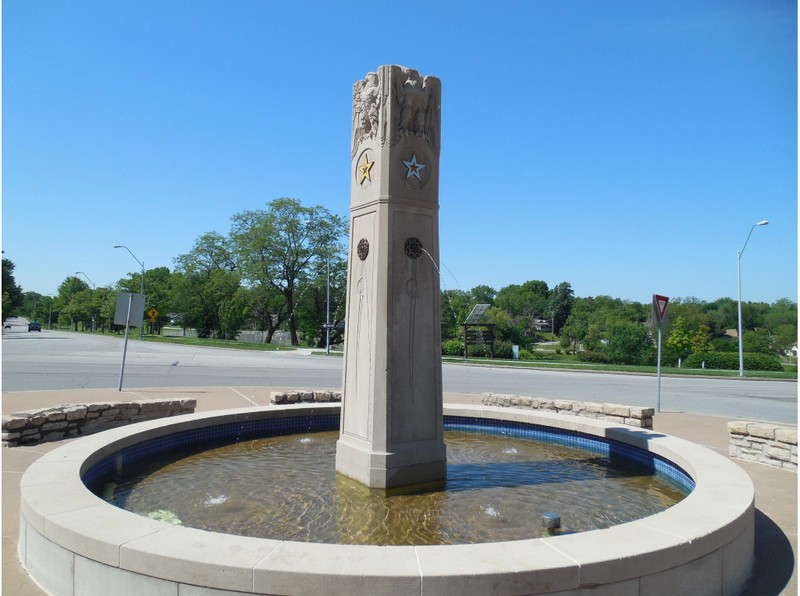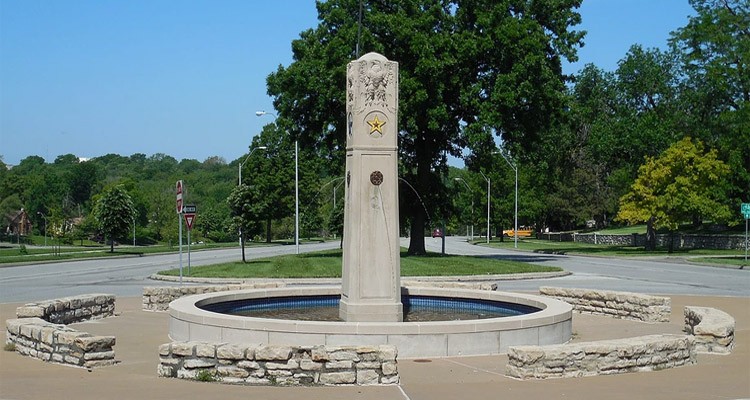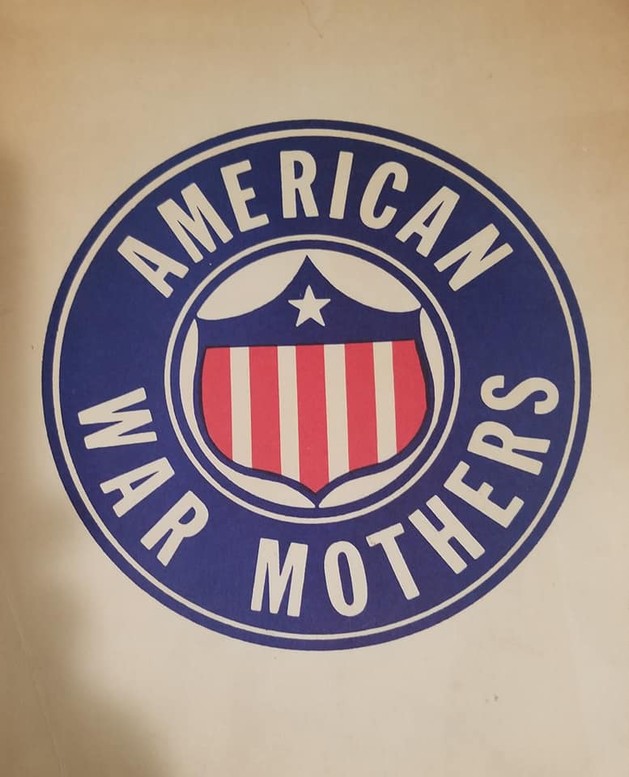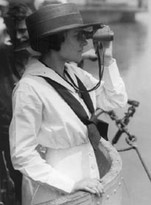American War Mothers Memorial Fountain
Introduction
Text-to-speech Audio
This fountain honors Kansas City area mothers during World War I. Dedicated in 1942 as America entered a second global way, planning for this monument began in the interwar period.This monument's emphasis on women's role as mothers reflects contemporary views on the primary role of women, and it also reflects the substantial contributions of women to the homefront along with the shared sacrifice of families. World War I saw the mobilization of American women, including in official military roles for the first time. Seven women received the Distinguished Service Medal during World War I, and 600 women died. As part of both the Navy and Army, women worked in such capacities as messengers, cryptographers, truck drivers, radio and phone operators, medical technicians, and mechanics, many of whom worked on the front lines. Additionally, women nurses contributed mightily, not just as part of the Red Cross but as members of the Navy and Army; many were wounded or killed in action. Today, this fountain honors those women who served in the Navy directly along with the many civilian jobs within the armed forces during World War I, as well as the original scope of the monument that honored mothers of soldiers. In the three years after this monument's dedication, America's entry into World War II saw a substantial number of women serve in the military and military auxiliary units.
Images
American War Mothers Memorial Fountain

American War Mothers Memorial Fountain

American War Mothers Insignia

A yeoman (F) on Submarine K-5 gazes through her binoculars.

Backstory and Context
Text-to-speech Audio
In 1917, a time when the nation still forbade women from voting, National American Woman Suffrage Association President Anna Howard Shaw proved instrumental in mobilizing American women for the war effort. Shaw founded the Women's Committee of the Council of National Defense to help the millions of women who desired to serve by matching them with a specific need. The organizations that employed women reassured the nation that women would not lose their feminity by taking traditionally male jobs – filling the void of men who had left to fight in the war. The Woman's Journal wrote in 1917 that tens of thousands of women joined "The Women's Land Army" to farm, freeing men to enlist in the military and assuring the nation and allies would have an ample supply of food.
It's not the first time women played a supporting role in a war effort, including during the Revolutionary War. During the Civil War, women gained acceptance from doctors and soldiers working as nurses. That tradition continued during World War I as eight million women volunteered for the American Red Cross, working in such capacities as sewing (making surgical dressings, masks, and gowns) and nursing. The Red Cross also organized a motor service almost entirely comprised of women (more than 10,000) who worked as motorcycle messengers, truck drivers, and auto mechanics. Meanwhile, Salvation Army "Lassies" operated close to the battlefront, providing soldiers with water and food, mending their clothes, and helping soldiers write letters.
But, World War I opened the door for women to contribute to the war effort in ways never before allowed by women, including becoming full-fledged members of the military. The U.S. Army enlisted nearly seven thousand women to work as switchboard operators, with 223 sent overseas. The so-called "Hello Girls" took the same oath of allegiance as soldiers, wore the signal corps insignia, received the same pay as male soldiers, and often worked near the front lines. Seven of the women received the Distinguished Service Medal. However, the 'Hello Girls" did not receive veteran's status or any of the benefits provided to their male counterparts, which was not rectified until 1979, after most of the women had passed away.
Women also joined the Navy as male enlistment proved insufficient to fully staff the abundance of ships built by the U.S. during the war. The ambiguous language of the 1916 Naval Act unintentionally opened the door to women volunteering in the U.S. Navy; they had been prohibited from doing so in previous wars. After examining the act, Secretary of the Navy Josephus Daniels determined that the Navy could recruit women. So, on March 19, 1917, the Bureau of Navigation informed commanders they could recruit women into the Naval Coast Defense Reserve to work in such roles as radio operators, cryptographers, stenographers, electricians, nurses, and messengers. Young women, including an abundance of suffragists, flocked to the recruiting offices, with the majority becoming yeomen (F), noting they were female yeomen. Lieutenant Commander Joy Bright Hancock was among the first women to enlist in the U.S. Navy; she rose to the rank of captain in World War II.
Nursing remained a pivotal position for women, but they did so as part of the military during World Wr I. Army and Navy Nurse Corps contributed 22,804 nurses to the war effort. Some women served at home, but many traveled abroad to work in military hospitals and troop ships. Lenah Sutcliffe Higbee, chief of the Navy Nurse Corps, became the first woman to receive the Navy Cross, which is second only to the Medal of Honor. Army nurses could be found throughout Europe and even as far as Siberia. Both Army and Navy nurses came home wounded, and some never made it home; more than two hundred Army nurses and thirty-six Navy Nurse Corps died in action.
The fountain, dedicated in 1942, honors mothers of American servicemembers and also women who made contributions to the war effort. The 18′ limestone obelisk includes metal stars on three sides: gold, honoring those who died in the war; blue, symbolizing those who were wounded; and white, representing those who returned uninjured. The official War Mother's insignia dons the fourth side.
Cite This Entry
Powers, Mathew and Clio Admin. "American War Mothers Memorial Fountain." Clio: Your Guide to History. September 17, 2022. Accessed March 28, 2025. https://theclio.com/entry/154859
Sources
"American War Mothers Memorial Fountain." The City of Fountains Foundation. Accessed July 25, 2022. https://cityoffountains.org/american-war-mothers-memorial-fountain/.
"American War Mothers Memorial Fountain." KC Parks. Accessed July 25, 2022. https://kcparks.org/places/american-war-mothers-memorial-fountain-2/.
Frahm, Jill. "The Hello Girls: Women Telephone Operators with the American Expeditionary Forces during World War I." The Journal of the Gilded Age and Progressive Era 3, no. 3 (2004): 271–93. http://www.jstor.org/stable/25144374.
Garner, Ana C. and Karen L. Slattery. "Mobilizing Mother: From Good Mother to Patriotic Mother in World War I" College of Communication Faculty Research and Publications (2012): 237. https://epublications.marquette.edu/comm_fac/237
O'Gan, Patri and Mallory Warner. "Mothers in World War I." National Museum of American History. May 6, 2016. https://americanhistory.si.edu/blog/mothers-world-war-i.
Patch, Nathaniel. "The Story of the Female Yeomen during the First World War." National Archives: Prologue Magazine, 38, no. 3 (Fall 2006). https://www.archives.gov/publications/prologue/2006/fall/yeoman-f.html.
Proctor, Tammy M. "US Women's Overseas Service in World War I." Missouri Over There. missourioverthere.org. Accessed July 25, 2022. https://missourioverthere.org/explore/articles/us-womens-overseas-service-in-world-war-i/.
Schmidt, Hannah. "American War Mothers Memorial Fountain is dedicated to those who served in World War I." KSHB Kansas City. kshb.com. Apr 21, 2017. https://www.kshb.com/lifestyle/tasteseekc/american-war-mothers-memorial-fountain-is-dedicated-to-those-who-served-in-world-war-i."
Schneider, Carl J. and Dorothy Schneider. "American Women in World War I." The United States World War I Centennial Commission. July 26, 2022. https://www.worldwar1centennial.org/index.php/communicate/press-media/wwi-centennial-news/4149-american-women-in-world-war-i.html.
Stars and Stripes, The American Soldiers' Newspaper of World War I, 1918 to 1919: Women and the War Effort. Library of Congress. Accessed July 25, 2022. https://www.loc.gov/collections/stars-and-stripes/articles-and-essays/inside-the-pages/women-and-the-war-effort/.
"Women in World War I." National Park Service. April 7, 2022. https://www.nps.gov/articles/women-in-world-war-i.htm.
City of Fountains Foundation: https://cityoffountains.org/american-war-mothers-memorial-fountain/
KC Parks: https://kcparks.org/places/american-war-mothers-memorial-fountain-2/
https://www.facebook.com/American-War-Mothers-of-Whittier-California-1453734134864043/
National Archives: https://www.archives.gov/publications/prologue/2006/fall/yeoman-f.html

